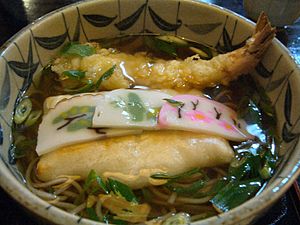Toshikoshi soba facts for kids
Toshikoshi soba (年越し蕎麦) is a traditional Japanese noodle dish. People eat it on Ōmisoka, which is New Year's Eve (December 31st). This special meal helps people say goodbye to the old year. It's believed that eating these easy-to-cut soba noodles helps you let go of any troubles from the past year.
Contents
The Story Behind Toshikoshi Soba
The tradition of eating Toshikoshi soba began a long time ago. It started around the Edo period in Japan, which was from 1603 to 1867. Over time, this custom spread across different parts of Japan.
Different Names for New Year's Soba
People in different areas of Japan have other names for this New Year's Eve dish. Some call it misoka soba or tsugomori soba. Other names include kure soba, jyumyo soba, fuku soba, and unki soba. Each name often relates to good luck or a long life.
Why Soba Noodles are Special
There are a few reasons why soba noodles are chosen for this tradition:
- Long Life: The long shape of the soba noodles symbolizes a long life. Eating them is like wishing for many more healthy years ahead.
- Strength and Resilience: Soba noodles are made from buckwheat. The buckwheat plant is very strong and can grow even in harsh weather. Because of this, eating soba also represents strength and the ability to bounce back from difficulties.
- Letting Go: As mentioned, soba noodles are easy to bite through and cut. This makes them a symbol of cutting away bad luck or hardships from the past year. It's a way to start the new year fresh.
See also
 In Spanish: Toshikoshi-soba para niños
In Spanish: Toshikoshi-soba para niños



